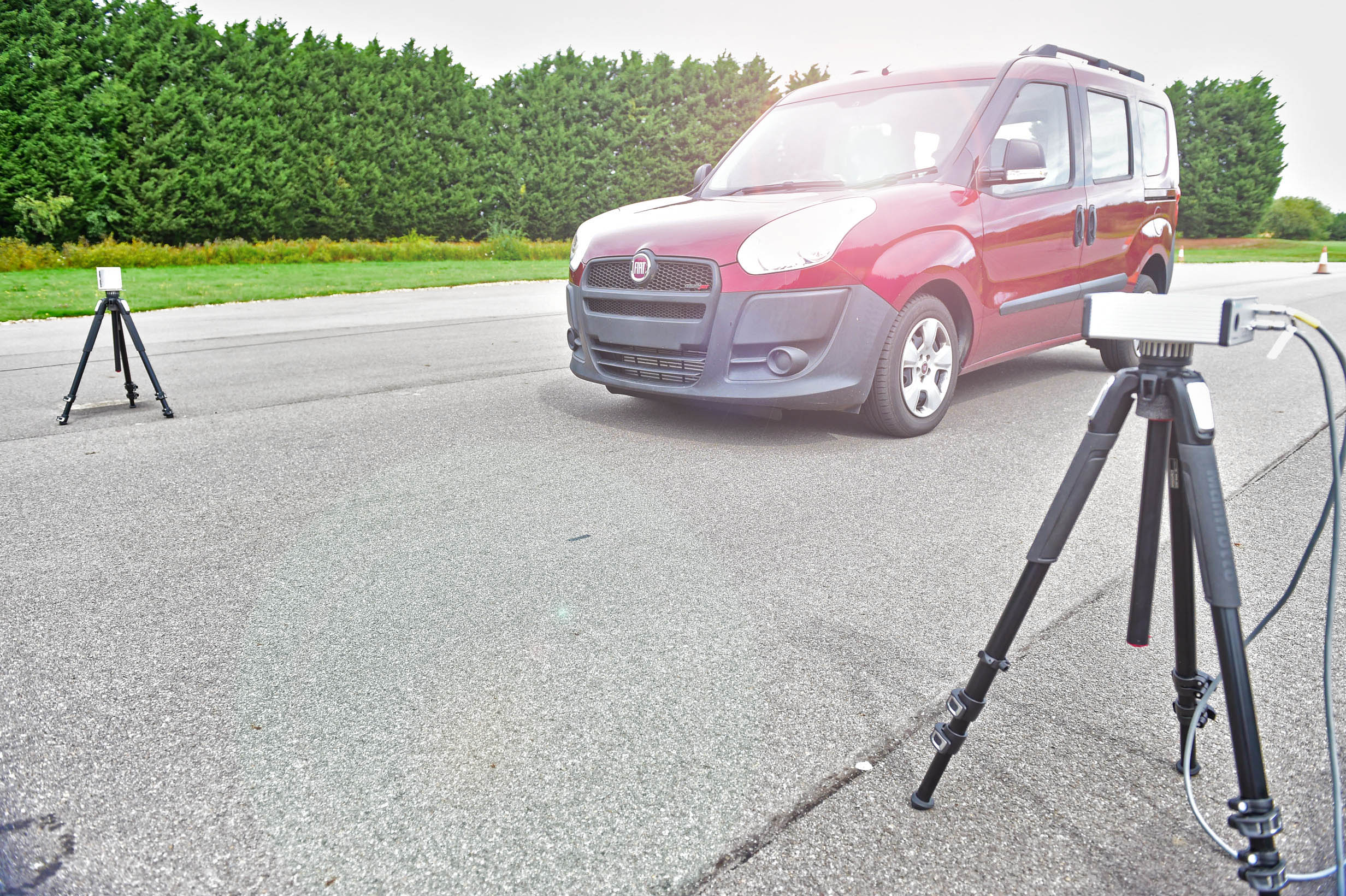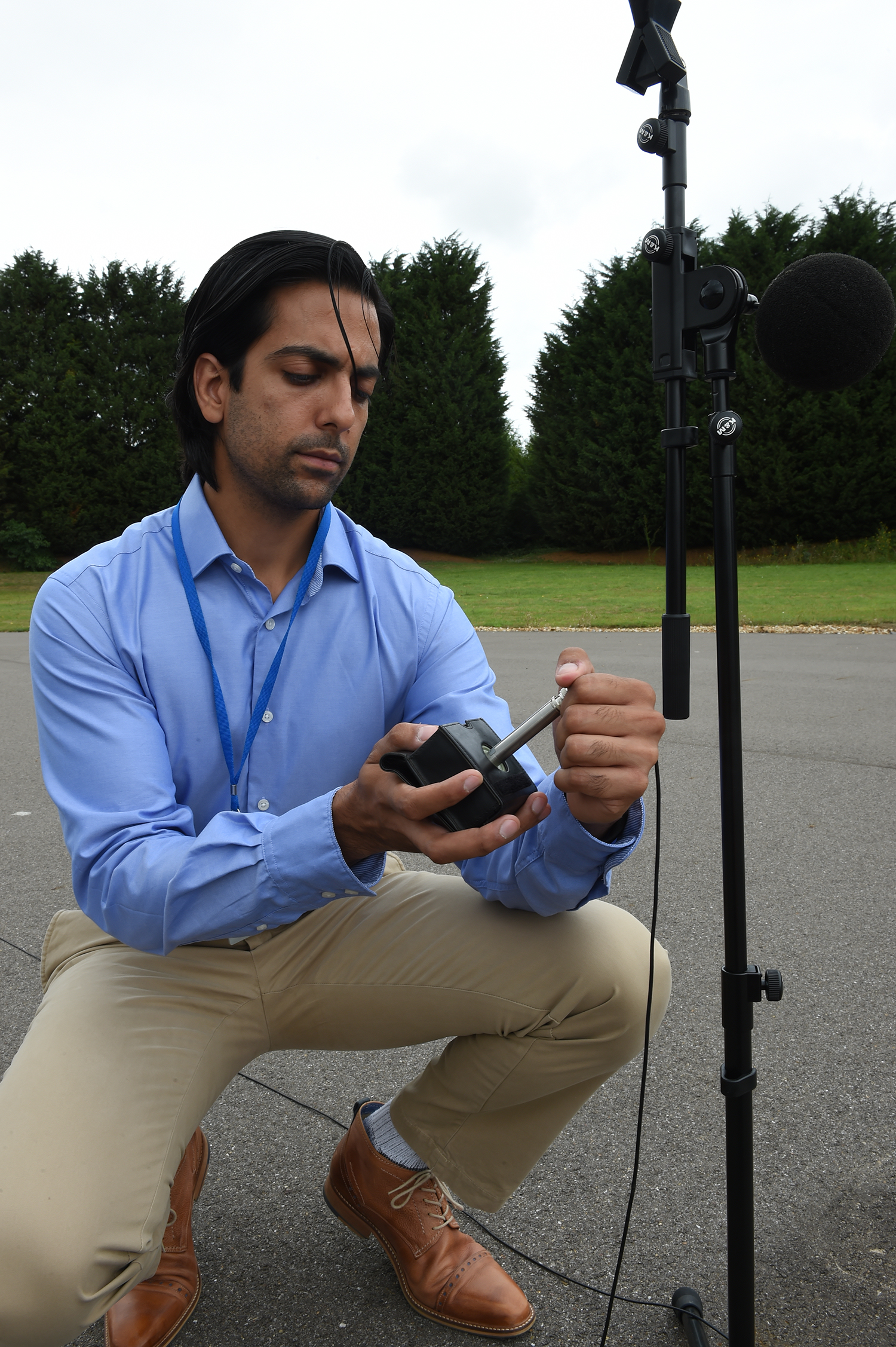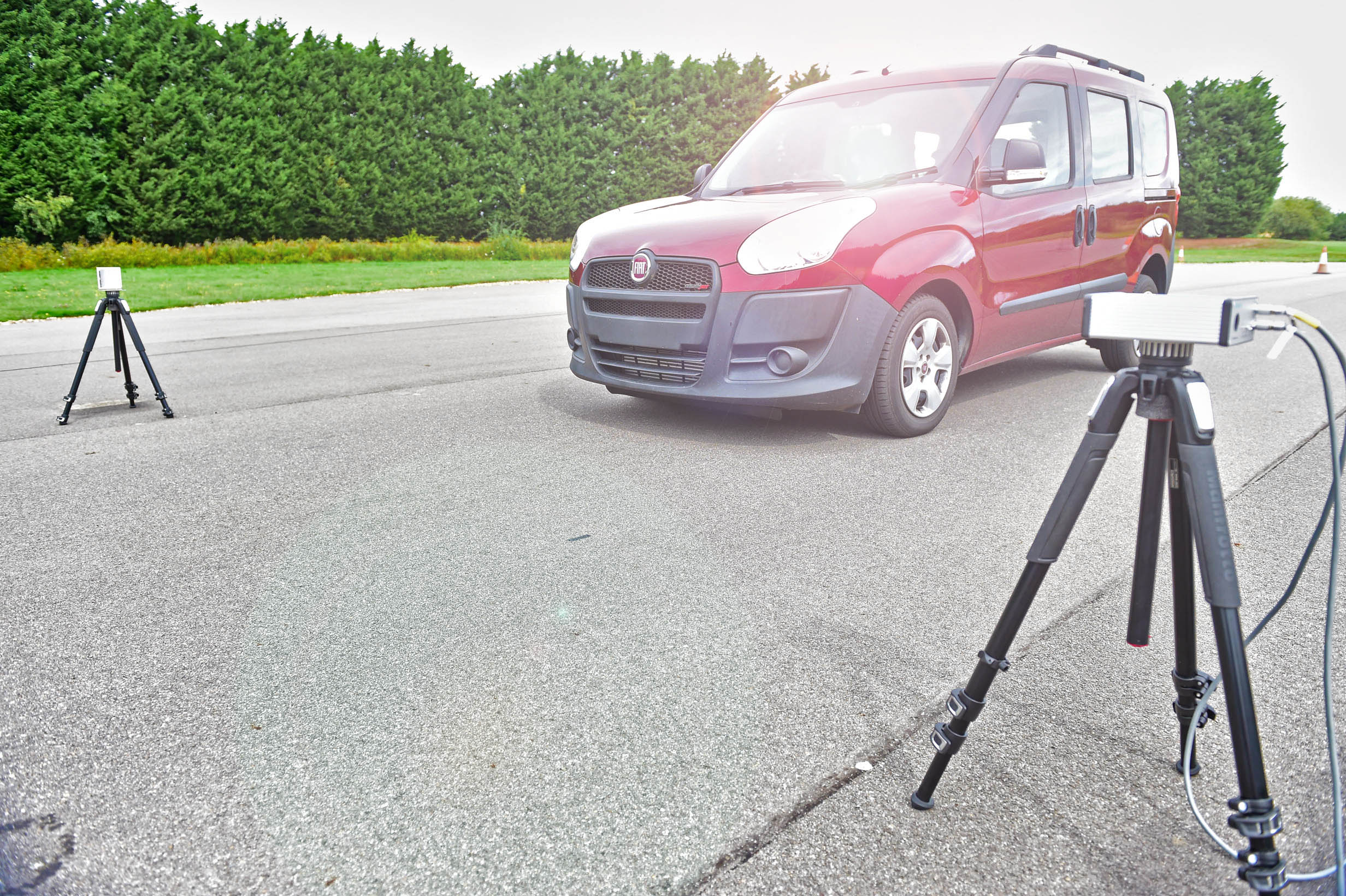 米尔布鲁克已获得一笔“可观的”投资,以升级该机构的噪声测量系统。
米尔布鲁克已获得一笔“可观的”投资,以升级该机构的噪声测量系统。 Ravi Bal表示米尔布鲁克正在考虑将声全息摄影术作为新型噪声测量系统的一部分。
Ravi Bal表示米尔布鲁克正在考虑将声全息摄影术作为新型噪声测量系统的一部分。 米尔布鲁克的新型噪声测量系统使用了西门子的技术。
米尔布鲁克的新型噪声测量系统使用了西门子的技术。 米尔布鲁克已经增加了对便携排放测量系统(PEMS)的投资。
米尔布鲁克已经增加了对便携排放测量系统(PEMS)的投资。
米尔布鲁克(Millbrook)是英国独立车辆测试、验证和工程服务提供商,该公司正在考虑引入声全息摄影术作为其新型噪声测量系统的下一步发展举措。
“我们的新型测试系统支持最新的汽车技术,包括电动汽车和混合动力汽车,并且能够引入更先进的测试方法,以减低噪声、振动和不平顺性(NVH),还可以进行测试以检验是否满足法规要求,并将调查结果和开发成果应用到车辆改进的过程中。”米尔布鲁克的首席工程师Ravi Bal说。
Bal解释道,新系统对声源定位和贡献分析来说非常理想, 而其功能还不止于此。工程师们将能够测量车辆内部的音响效果和振动,并且将测量结果与外部记录数据同步,在重复测量环境中实施多种客观测量。
老系统已经运营了20年,Bal说:“尽管一切都已经数字化了,但对于高效而准确的数据分析来说,仍存在许多限制。因此,在新设备方面,无论是硬件和软件,我们都已投入巨资,目的是提升我们的测试能力,以及引入更先进的测试方法。
原来的双频道设置已经升级为更先进的16频道:“我们正在考虑引入声全息摄影术,这是一种必要的声学摄影机,可以直观的指引声源,并且突出显示潜在问题区域。这需要让很多麦克风形成一个阵列,我们的16频道设备完全能够实现这一点,并且还能够通过增加麦克风数量来提高空间分辨率。”
Bal强调,由于便携式排放测量系统(PEMS)获得的投资及其测试部门能力的提升,加上其他升级的实现(包括米尔布鲁克测力仪的升级),新的噪声系统提供了测试、调研的新可能,并有机会使设备水平远超法规基本要求。
米尔布鲁克的噪声测试工作在2012年得到提升,当时引入了ISO 10844:2011规格的噪声测试路面,提供了对车辆噪声进行调研和了解的高级设备:“尽管欧洲法规对车辆型式认证的要求并未如2014年预计的一样有所进展,但米尔布鲁克仍代表了开发测试和发展噪声解决方案的最先进水平。”
全球噪声测试等级
关于引入全球范围内监管立法等级的工作仍旧在商讨之中,但我们现在很难确定下一个法规变化的时间。
Bal认为欧洲的噪声旁路限制“相当严格”。这些限制应用于所有车辆,包括高能效车型,该车型适用于欧洲共同体整车型式认证(ECWVTA)框架指令。ISO 362设立于1981年,是一项固定测试程序,在今年做了修订。但目前,欧洲法规标准仍在使用1998年的版本。
他解释说:“市场要求高性能车型具备‘正确的’车型尾气噪声性能,而我们完全可以做到!”现行的车型认证测试方法不同,根据车型的输出功率和车辆的变速箱型号而定。”
“比方说,一辆车的输出功率为100 kW,装有手动变速箱(米尔布鲁克分类M1),在入口速度为50 km/h时测试第二档和第三档。在指定线路AA的某一个特定地点,车辆以“超大”油门加速运行20米,然后加速器停止运转。第二档和第三档的测试结果取算数平均值,该数值必须低于适用于此类车型的噪声限值。应该将大多数现代车型考虑在内,也就是拥有电子油门的车辆,当驾驶员踩下加速踏板时,他并不是在给车辆提速,而仅仅是让车辆行驶更快。此种情况下噪声限值为74分贝(A)。”
但是,对于输出功率大于140 kW(以及其他规定)的测试车辆来说,必须只在选定第三档的前提下进入测试区域,因为通常这样会更加安静(因为发动机转速小于二档的时候),但如果规定这种情况下的数值为1分贝,而测试结果的限制定为75分贝(A),通过测试的难度是很高的。
电动汽车和混合动力汽车的发展,给噪声测试提供了一个崭新的契机。Bal解释说:“基于我们的经验,我们认为分贝数值从中等到接近70是正常情况,轮胎噪音是主要的噪声源,轮胎制造商需要申报轮胎产生的声压——尽管轮胎噪声测试方法与整车不同。
电动车的轮胎噪声降低之后,增设一个人工的人行道预警系统就更为必要。这是噪声测试的另一个层面。Bal想要看到一种在主要频率下最低声压的限值:“这些主要频率应该通过使用与个人声音感知相关的数据进行规定。比如说,行人是否可以听到典型的背景噪声?因此,电动车所发出的声音不能仅仅设计为持续的嗡嗡声,还要有辨识性。”一般来说,比较适宜的噪声等级约为46分贝,米尔布鲁克噪声场的环境有利于获得精确的测量数据。
路面测试
尽管米尔布鲁克有一个控制路面测试区(ISO 10844),且测量装备满足ISO 362的要求,因此测试结果可以作为参考。轮胎噪声测试本身并不属于米尔布鲁克的测试内容,但Bal表示提供这种参考的可能性正在商讨中。这很有可能需要大规模投资,而且不同地区的标准不同,情况就更为复杂。Bal 认为, “欧洲轮胎规定R 117有四个标准:潮湿路面附着力、滚动阻力、雪地性能和噪声水平。通过实验测试,我们可以分析噪声,但这是一项非常复杂的工作。轮胎必须装载到最大允许载荷量的特定百分比水平。”
如果米尔布鲁克确定涉足轮胎噪声测试领域,该机构也将会进行另外三个领域的测试研发工作。Bal补充道:“滚动阻力的测量相对更容易,但湿地附着力的测试需要我们进行更多投资。我们与测试世界(Test World)合作,这是芬兰的一家冬用车和轮胎测试公司。”这也有助于在全年的时间内方便获得冰雪路面的测试环境。
Bal希望米尔布鲁克最终可以测试整车噪声等级、车身结构、接触面积、空气动力学特性,以及车辆动力总成所带来的影响。
但他希望建立一种通过不同程序创建的新型测试规程:“现阶段是由立法者决定需要哪些测试规程,但如果能够达成一致,使用更加实际的测试方法,并在早期决策阶段就考虑到整车厂和供应商的看法,将能够可制定出对汽车行业发展更合适的标准。”
作者:Stuart Birch
来源:SAE《汽车工程杂志》
翻译:SAE 上海办公室
Millbrook’s latest sound advice to the auto industry
UK independent vehicle test, validation, and engineering services provider,Millbrook, is considering introducing acoustic holography as the next step in the further development of its new noise-measurement systems.
“Able to support the latest automotive technologies including electric and hybrid vehicles, our newly commissioned system provides a great opportunity to introduce more advanced test methods to reduce NVH, test to regulatory requirements, and facilitate investigation and development into improvements in vehicle refinement,” said Millbrook’s Principal Engineer, Ravi Bal.
He explains that the new system is ideal for (but not limited to) sound source localization and contribution analysis. Engineers will be able to measure acoustics and vibration inside a vehicle and sync it with data recorded outside, conducting a variety of objective measurements in a repeatable test environment.
The system that it replaces had been in service for 20 years, stated Bal: “Although everything was digital, there were limitations for efficient and thorough data analysis. So we have made a substantial investment in new equipment—both hardware and software—to expand on our test capability and to introduce more advanced test methods.”
The update has seen an advance from a two-channel setup to a 16 channel: “So we are looking at the introduction of acoustic holography, essentially an acoustic camera that can visually indicate sound sources and highlight potential problem areas. This requires multiple microphones built as an array, so our 16-channel capability allows us to do exactly that, with potential scope to improve spatial resolution by increasing the number of microphones used.”
Together with other upgrades, including Millbrook’s dynamometers, investment in its Portable Emissions Measurement System (PEMS), and increased capability within its test department, the new noise system provides the opportunity to test, investigate, and develop “way beyond” basic regulatory requirements, stressed Bal.
Millbrook’s work on noise was enhanced in 2012 with the introduction of an ISO 10844:2011 specification noise test surface, providing an advanced facility for investigating and understanding vehicle noise: “Whilst the anticipated update to European legislative type approval requirements did not go ahead as predicted in 2014, Millbrook remains at the forefront of the latest technology for test and development of noise solutions.”
Global noise test level
Efforts to introduce a global regulated legislative level are still under discussion, but it is difficult to say when the next legislative date will be.
Bal regards European pass-by limits on noise as being “fairly stringent.” They apply to all vehicles, including high-performance cars that are applicable to the European Community Whole Vehicle Type Approval (ECWVTA) framework directive. There is a fixed test procedure—ISO 362—first established in 1981, which was revised this year. Currently, though, the European regulatory standards use a 1998 version.
He explained: “With regard to high-performance cars, the market requires they have the ‘right’ exhaust note for their type—we all do! The current Type Approval test method varies according to the power output of the vehicle category and transmission type of the vehicle.
“As an example, a car with power output of 100 kW and manual transmission (categorized M1 by Millbrook), is tested in second and third gears at an entry speed of 50 km/h. At a specific point, designated Line AA, the car is accelerated on a “wide open” throttle for 20 m and then the accelerator is lifted. In second and third gears, a mathematical average is applied to the results and that must be below the limit applied to that particular class of vehicle. It should be considered for the majority of modern vehicles, that with electronic throttles, when a driver presses the accelerator pedal he is not making the vehicle’s speed increase but merely requesting that it should go faster. The limit is 74 dB(A).”
However, for test vehicles with a power output greater than 140 kW (and other stipulations), it is required to enter the test zone with only third gear selected, which typically tends to be quieter (lower engine speed than in second) but is given a 1 dB provision for its class, consequently raising the limit to 75 dB(A), which is a challenge.
The market emergence of electric and hybrid vehicles has brought a new dimension to noise testing. Bal explained: “We regard dB figures of mid to high 60s as the norm for these vehicle types based on our experience, and we attribute most of this to tire noise, with tire manufacturers required to declare the sound pressure generated by the tire—although this is tested via a different methodology to the whole vehicle.”
Reducing tire noise in electric vehicles increases the need to consider an artificial approach-warning systems for pedestrians. This is another aspect of noise testing. Bal wants to see limits that require minimum sound pressure levels at key frequencies: “These key frequencies should be established using data relating to a person’s perception of sound, i.e., can they hear it over a typical background noise? Therefore, creating a noise that is more than a constant drone, and distinguishable as an electric vehicle.” With a typical ambient noise level of around 46 dB, the situation of Millbrook’s noise site is conducive to achieving accurate measurement data.
Surface test
Although Millbrook has a control surface test area (ISO 10844), coupled with measurement equipment applicable to ISO 362 that can be used as a point of reference, tire test noise per se is not part of Millbrook’s work, but Bal says the possibility is under discussion. Potentially, it would involve a large investment and, again, varying standards across the world would present complications: “The European tire regulation R 117 has four elements: wet grip, rolling resistance, snow performance, and noise. We can assess noise by using a test trailer but it is quite an involved program. The tires have to be loaded to a set percentage of their maximum permissible load carrying capacity.”
If Millbrook did move into tire noise testing, it would also want to enter the other three categories, too. Bal added: “Rolling resistance is relatively straightforward, but wet grip would require further investment. We work in collaboration with Test World, the winter vehicle and tire test facility in Finland.” It facilitates access to snow all year round.
Bal hopes Millbrook will eventually test whole vehicle noise levels, embracing vehicle body structure, contact patch, aerodynamics, and powertrain contributions.
But he wants to see any new test regulations created via a different procedure: “At present, the perception is that legislators decide what is going to be required, but if a more pragmatic approach could be agreed, taking into consideration OEM and suppliers’ views at the earliest stage of decision making, a more appropriate conclusion for the industry could be reached.”
Author: Stuart Birch
Source: SAE Automotive Engineering Magazine
等级
打分
- 2分
- 4分
- 6分
- 8分
- 10分
平均分
- 作者:Stuart Birch
- 行业:汽车
- 主题:噪声、振动与声振粗糙度质量、可靠性与耐久性测试与检验
